
Re-structuring Your Design Firm During a Recession
by Rebecca Firestone with Mark English AIA | Other Voices
“In this prolonged recession, we have two choices, it seems: We can hibernate for a number of years, like Rip Van Winkle, waking conveniently to a new world. Or we can make the time to consider new business development strategies that highlight our firm’s value and that put us closer to new projects. Concurrently, we can consider ways to improve our ability to stay abreast of trends in technology and practice.
The reality of global outsourcing is likely to change the nature of firms of every size. Our day-to-day tasks may shift from directing in-house staff to one where we review outsourced documents for design and code compliance. Can you fit in, and if so, how?”
This is a follow-up to our earlier post on KA Connect, a conference on knowledge management for architects.
Michael Bernard writes: Here we are in the quiet of 2010. Think back two years ago: July 2008. The Dow Jones Industrial Average (DJIA) stood at 11,326. Many firms were busy with abundant work, months of assured work in the pipeline, and stunning new prospects to fill in the void. Finding qualified staff to handle the copious workload was the major challenge. Entry-level designers who entered the job market in May 2008 had the prospect of three or maybe four offers of employment.
None of us could have easily predicted that, three months later, the stock market would drop almost 3,000 points. Nor could we have predicted that five months later, the Dow Jones Industrial Average would drop to 6,626 points. Eventually, in a span of under eight months, the stock market dipped 4,700 points. By December of 2008, the outlook was as gloomy as the winter weather, with no end in sight.
Of course, the world did not entirely come to an end. Since March 2009, the market has recovered somewhat. However, despite the market’s apparent recovery, the architecture and interior design professions are not seeing the same rebound in inquiries and signed contracts. Unemployment among design and construction professionals still stands between 15 and 20 percent. Clients who still have funding for their projects continue to drive hard bargains on both soft and hard costs. Clients who don’t have the money in hand are having difficulty financing, despite the fact that money has seldom, if ever, been less expensive than it is today.
What’s more, we recently received discouraging news in a newsletter from the AIA:
” . . . the AIA Consensus Construction Forecast Panel was downbeat on the prospects for the year [2010], projecting a 13% decline in spending (inflation adjusted) for nonresidential building projects. Halfway through the year, prospects have deteriorated, with the current consensus predicting a 20% decline this year.”
Link follows here.
What does all of this mean to the average small or medium-size design firm? Many firm owners are working twice as hard to capture half the commissions, and those contracts are likely to be smaller in scale and lower in value – leading to leaner design fees. In an uncomfortable turn of events, we may find ourselves competing against our colleagues in market sectors where that was formerly not the case, such as single-family custom homes.
Meanwhile, the evolution of technology in everyday practice continues, even in the absence of billable projects. Software licenses expire regardless of economic swings. Computers become obsolete. The employees we have been fortunate enough to retain now need to learn new programs to stay current. Our servers are undersized and sometimes cannot handle the new software. Our bandwidth/DSL is inadequate. In order to compete with our colleagues, we now want software to track every hour spent on every project in order to understand what a project actually costs us to deliver. Large-scale projects are increasing in complexity, requiring ever-tighter integration between disciplines and wholesale data conversion from 2-D drawing libraries to 3D building objects. (Translation: more training, more software and more hardware, more overhead cost – when we can least afford it)
And we are two years into a recession, the end of which has been predicted unsuccessfully a number of times.
Paul Downs, a Philadelphia-based cabinetmaker, chronicles his efforts to balance cash flow and technological evolution in his New York Times blog post, “You’re The Boss”. In his post, Mr. Downs makes the ironic observation that, while he builds durable objects intended to last a long time, software is designed with the opposite premise in mind. And the software costs money that we might otherwise spend on business development and/or staff retention.
We have two choices, it seems: We can hibernate for a number of years, like Rip Van Winkle, waking conveniently to a new world. (For most of us, this is not a viable option.) Or we can make the time to consider new business development strategies that highlight our firm’s value and that put us closer to new projects. Concurrently, we can consider ways to improve our ability to stay abreast of trends in technology and practice.

Left: Washington Irving's character Rip Van Winkle woke up after a 20-year sleep. Right: Hibernation pods have been a popular sci-fi storytelling device, but the sleepers don't accomplish anything in the interim.
[This is easier if you can optimistically treat your down time as a sabbatical, an opportunity to update your infrastructure in ways that you don’t have time to do when you’re busy. You won’t accomplish much by viewing the recession as a punishment imposed by circumstance. – RF]
Staying abreast is more than just learning the newest version of ArchiCAD, though. It’s more than springing for a bunch of new software licenses and computing equipment. Now is a good time to think about how you run your practice, especially how you organize and store information. Technology sometimes makes familiar tasks faster, but it’s also an enabler that can sometimes open up a whole new way of doing things. Technology enables knowledge: how you acquire and share knowledge, how you store that knowledge in a meaningful way, and how you organize information to find things quickly.
This past April, I attended the inaugural meeting of Knowledge Architecture, KA Connect 2010. I listened to a wide range of perspectives on the evolving nature of capturing and disseminating design and construction knowledge. The speakers proposed that such knowledge is its own form of “architecture” that gives organization and structure to design practice, to construction, to collaboration and to learning. Many of the short talks are available here. They represent an accessible trove of (no-cost) knowledge that can help you in your daily practice. I encourage you to take a few minutes to view these talks, which add a new perspective to the world of design and construction.
Two of the speakers at KA Connect focused on very different strategies for changing how we practice, asking two important questions:
- How can we leverage our existing resources to distinguish ourselves from the rest of a highly-qualified pack?
- How can we stay nimble and responsive in an unpredictable marketplace?
Communicating Value To Your Clients
In her talk, “Communicating Value to Your Clients and Prospects”, Nancy Kleppel addressed the perennial importance of fostering a design culture where the entire firm is engaged in the effort to communicate value to (new and repeat) clients. We must communicate to our employees the essence that drives us to pursue our projects: is it for love? Or is it for money? Employees in turn should be coached and encouraged to communicate their awareness of value to clients in every interaction. By creating a “project landscape”, where the value, significance and relevance of every project is understood by each member of our team, we can grow our firms not just in size, but more importantly in depth of technical and business development expertise.
Nancy Kleppel writes:
“We begin by evaluating who we are as designers, what defines our own individual firm and separates us from our many competitors. This requires an in-depth understanding of not only the kind of work we do, but what we do best. We then must continue to develop our understanding of which of our attributes are most highly valued by our targeted clients and which of our projects best demonstrate our specific abilities. Next we need to create a common understanding across the firm that speaks to our specific firm attributes, talents, skills, mission and values. This must be clearly communicated to all staff in such a way that any one of them is able to serve as an ambassador for the firm in the full range of unpredictable circumstance where opportunities might present themselves. (We should also train them to recognize opportunities, but this is beyond our current focus.) Finally we must empower our staff to speak with a common voice, making it known that business development cannot be the provenance of a single individual or even a small group and create a firm structure whereby people who bring work into the firm will be properly recognized and rewarded.”
Global Outsourcing: Better Get Used To It
Darren Rizza, CEO of Satellier, addressed the reality of global outsourcing, which is likely to change both the nature of firms of every size, and the range of services they deliver. Highly-educated, low-cost design professionals outside of the USA can work around the clock to deliver high-quality design documents using the latest software. They can convert drawings to 3D building objects, offer libraries tailored to local building codes in other parts of the world, and even leverage expertise that will win YOU new work.
The result? Being able to do more with less, with the architect of record efficiently providing services that focus on the initial design vision followed by subsequent document review for the duration of the project. This may be the future of practice for some of us: “on-shoring” services that rely on creative and intellectual design leadership, while the “big middle” of a project may actually be produced off-shore. This project delivery method is of increasing appeal to many clients who are bottom-line driven. If this becomes the desired means of delivering projects, we need to train now in order to respond quickly to our client’s requests. If we are not ready – someone else will be.
Business is currently “light” for many of us, to put it mildly. The “on-shore/off-shore” paradigm may seem like a remote possibility. Its appeal to clients may not be apparent today, when the demand for design services is temporarily low. But as project inquiries increase in frequency and predictability, when funding is more easily available, clients will invest their hard-won funds in hard costs, with the possible effect of even leaner design fees.
Meeting the demands of a lower fee for service might be accomplished through carefully-structured outsourcing. The potential effect of such global outsourcing is that the very nature of how we practice may change. Rather than the traditional design practice hierarchy of “junior-intermediate-senior” staff, we may find that we are better suited to a “senior designer-job captain-document reviewer” arrangement, with a very small number of junior designers to support the initial design effort.
Our role as design service providers may evolve into one that is largely editorial and less supervisorial, as globally-produced data models find their way into our FTP drop-box. Our day-to-day tasks may shift from directing in-house staff to one where we review outsourced documents for design and code compliance. Consider this as a possible paradigm. Can you fit in – and if so, how? Would you and your staff be able to embrace such a prospective arrangement? And, assuming that you want to take the leap to try this new approach, how do you structure your firm so that delivery of services in this manner generates revenue?
Workshare: The New Word for Outsourcing
Darren Rizza writes:
“The opportunity to rebuild your firm as the industry comes back slowly will require new ways of putting teams together and producing design, analysis and construction documentation and modeling. The majority of firms have scaled down to their ‘A’ teams. But these teams may not be able to provide all the necessary services and billable hours for a project.
“How do you as a firm/project leader re-staff without affecting your bottom line profitability? Workshare, or outsourcing, is a logical path for recovery given its low cost/high value. Workshare is not only about staff, it is truly about process. Your workshare team needs to understand your design services process and execute it as you would. Typically, the workshare team would be task driven leaving the design aspects to the client. However, even this is shifting as those who have utilized workshare for years before the downturn are now better equipped to have design services executed through workshare thus reducing their internal needs while maintaining and in some cases increasing their ability to service more projects and clients.
“Need to execute in BIM? Don’t have BIM processes in place? Don’t have BIM software and really can’t afford the upgrade investment? Workshare is seeing significant increases in clients who are requesting or requiring services to be executed in a BIM process. In fact, more than 50% of all new workshare services involve BIM processes.
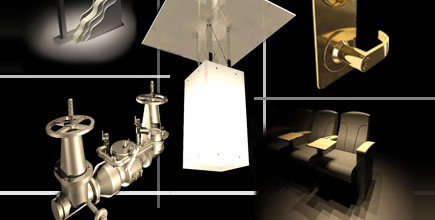
Pre-created Building Information Modeling (BIM) objects can save a lot of re-drawing time. These examples are available from Reed Construction Data.
“Workshare is not limited to architecture and engineering firms only. Increasingly, contractors and owners are seeking out workshare services to help improve their visibility into their projects as well as gain process knowledge they may not have on their teams. Owners now more than ever realize the benefits from a BIM or virtual design and construction [VDC] process and are now seeking workshare services for the management of their project as a way of managing the overall project and multiple team partners.

Virtual Design and Construction (VDC) can be used among other things to simulate construction sequencing, generate construction documents, and detect conflicts prior to construction.
“Our projects are no longer in our own backyard. Our building products and materials are not sourced from our own backyard. Our hardware, software and support are not from our own backyard. Our internal project teams are no longer from our own backyard as well. The recovery is shifting the balance. Flexibility and responsiveness will allow us to move forward successfully.”
Outsourcing: Friend or Foe?
Rebecca Firestone writes: As soon as people hear this particular word they think, “American jobs lost!” but actually, it can be a gain as well. I spoke at length with Darren Rizza to ask him some hard questions about outsourcing. His answers about how to get the most out of it – even for small firms – were very enlightening. Let’s face it, architectural firms have always outsourced the work they don’t want to do themselves, tasks that are not part of their core competency – marketing or tax accounting, for example. But now for the first time A&E firms are exporting large chunks of design work as well.
Outsourcing as a buzzword got its start with the information technology industry, when it became synonymous with “offshoring”, i.e., the moving of jobs overseas. (Prior to that, the migration of manufacturing jobs overseas was simply called “the migration of manufacturing jobs overseas”.) Customer call centers were next, moving to places like India, Ireland, or the Philippines. Now, people travel to India even for surgery. What’s next… outsourcing our hangovers (now there’s a thought)? It doesn’t matter if we view outsourcing as friend or foe, because we’ll have to embrace it in some form or another.
Below, Darren Rizza of Satellier, a company providing outsourced services to the architecture and engineering industries, answers questions from Rebecca about the meaning and value of outsourcing for firms large and small.
How do I know when to outsource? Are any of your remarks applicable to small design firms that work locally on one-off custom residential projects for private owners?
Darren: Regardless of what you’re outsourcing, you have to start with one fundamental question, namely, what do you consider your core business to be? Your core business is what sets you apart, why you are here. These functions are things you might want to control very closely.
But there are other tasks that we all have to do as part of our primary professional function, about which we say, “I don’t come to work to do this”. Outsourcing should make your processes more succinct. You don’t necessarily have to outsource across continents, either. You can find outsourcing firms in Iowa now, because the cost of labor is still lower there than it is in places like New York.
Small firms might outsource other functions, like accounting, legal, or HR – not necessarily A&E.
How do I know if my firm is organized to outsource successfully?
Darren: You have to understand your own process steps first, regardless of whether you outsource or not. Whether you’ve got six people in one office at home, or 75 people abroad, you have to determine:
- Who needs to do each one
- Where are the handoffs
- What are the yes/no decision points
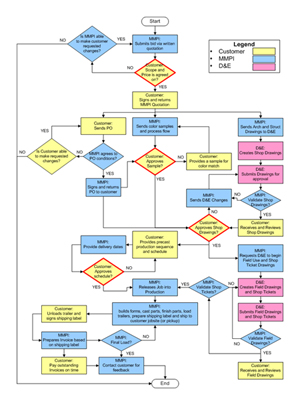
Before you can outsource portions of your own work process, you need to understand the process, including decision points (shown here in this example as diamonds), and who is responsible for each task.
Good communication is essential! There should be shared understanding about the tasks, such as how long each one takes. Then you have to work out how change management is handled, including notifying stakeholders. In fact, I’d say of all the things that make for successful outsourcing, change management is in the top 3.
How do I select a good firm to outsource to? How do I kick their tires to see if they know what they’re doing?
Darren: If you’re outsourcing out of your local area, you will have to consider how to do business across a different continent, culture, and legal rules. Whatever your industry, you want to ensure that your needs will be met by the service provider. Look on CIO.com for the top 100 questions you should be asking your outsource service vendor [page no longer available]. Although many of them pertain to the information-technology industry in particular, many of the questions are applicable outside of IT.
Questions like:
- Why are we doing this?
- What are the success criteria?
- How much experience does my organization have with managing outsourced engagements?
Specfic content-related questions that you can ask a provider for A&E include asking them to show their details for things like doors, ceiling plans, framing plans, vertical circulation. These can serve as dictionaries, and are valuable aids. By looking through these templates, you can see what they know, and what they can potentially reference. If there is a discrepancy between the building codes that they use in their details and the ones that your project needs to use, this will also be apparent.
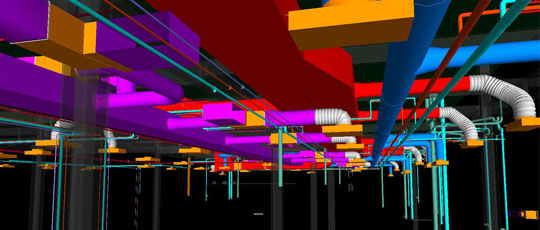
Ask the outsource vendor to show you some of their typical detailing, and see how close it is to what you would need for your projects.
The provider should also have experience working with Westerners – including your region, as well as experience with the type of project you want to do.
What are the logistics of moving to an outsource provider?
Darren: Again from CIO.com, here’s a sampling of checklist items that you should take into consideration.
- Is there a master services agreement in place?
- How long will it take new supplier resources to learn their jobs?
- Will there be layoffs among my staff?
- How should I divide the project work among several suppliers in different locations?
- How can I get enough sleep when my project team is on different continents?
- What are the major holidays? When can I expect to find people in the office and when not?

In the "Dilbert" comic, the fictitious nation of Elbonia somewhere in Eastern Europe serves as a stand-in for offshoring jokes without having to offend any "real" nationalities.
What’s a good sort of trial project to use with a new outsourcing firm?
Darren: One major task in adopting new technology is simple data conversion. A small firm could use outsourcing to convert all their existing 2D libraries into 3D building objects. If the firm is looking to grow and embrace new technology, this is one way to get a leg up. It’s a lot quicker than trying to learn the tool and doing all the conversion yourself.
How do I get off on the right foot with my outsource team?
Darren: You need to allow for some ramp up time. Give some thought to the types of projects and length of engagement. Once the new team has learned how you work and what your expectations are, they can truly be an additional right and left hand for you.
You also have to remember that the outsource team are people. Another aspect of Indian culture to consider is that people will be extremely dedicated to their work will leave a company if they don’t like it. If they don’t like the people, or they don’t like the work, or the commute is too long, they’ll leave. Many people live with extended families and can afford to change jobs but more to the core of motivation is their belief of personal happiness. So you have to give feedback, compliment the team for doing things like meeting a major milestone. In meetings, you should praise the entire team, not individuals – you can always praise individuals in private.
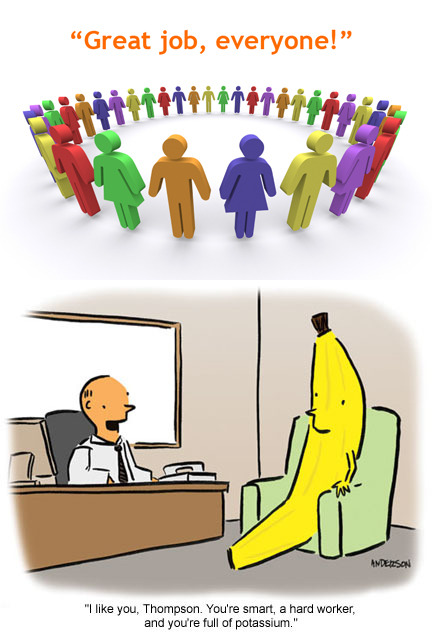
In some cultures, it's important to praise the entire team in group meetings. Offering individual praise is best done in private, to avoid the appearance of slighting the other members of the team.
A few years ago, when Satellier was really busy, U.S. clients would send over gifts like coffee mugs and caps. Even small firms can do this. The remote teams want to know who they’re working with and what they’re doing. So you can, for example, post things like photos from the San Francisco team’s outing, sharing day-to-day experiences. Learn who the individuals are on your team – learn their names and pronunciation, learn their backgrounds of education, family, from where they come. A lot of people may not understand the importance of this effort, but it makes a big difference in building tight connections.
My feeling about new technologies was that they trickled down eventually. They might start as the sole provenance of large firms, but then 10 years later everyone’s got it right on their desktop.
Darren: Do technologies trickle down? Not necessarily. Larger firms may adopt greater quantities of technology. But some alternatives may disappear over time due to consolidation.
The trickling that happens tends to be across firms. Employees at one firm may take their tools, preferences, and processes with them when they change companies. This can happen from large to small firms, but also from small to large. That’s one way that stuff gets adopted.
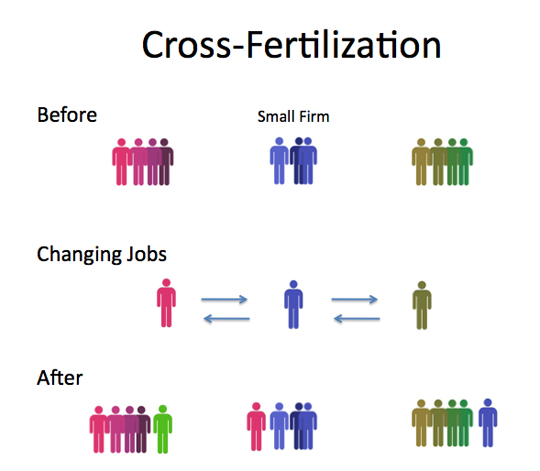
As staff move from one firm to another, they bring new knowledge, tools, and methodologies. Firms can thus acquire skill diversity without sacrificing their core competencies.
This “stuff” can include new work processes, ideas, and methodologies. It can be disruptive, or not. Sometimes there’s a temporary disruption in efficiency that I call a type of “bubble”. There’s the disruption, there’s the bubble as the company learns to deal with the new information, and then things settle down again. Outsourcing, and offshoring, is one of those bubbles.
How much visibility does each team need? If they only understand their piece, they can’t spot discrepancies that could affect things later on the way an integrated team would.
Darren: Who says outsourced teams can’t be integrated?
The question is how much visibility into adjacent pieces should a team have. More insight does lead to smoother understandings. It’s good for the teams to understand how the outcomes of their tasks affect things down the road. Although most schedules are expressed in terms of daily or weekly deliverables, these deliverables can have a conditional effect.

The more visibility the team has into the overall process, the better they will be able to contribute.
The management team must provide guidance to the outsourced teams so that those teams can make decisions with forethought. Even rote tasks require some decision making. For example, in an office building, how does a particular door operate? What codes will it need to meet? If the person designing or configuring that door doesn’t know what the next steps or the needed outcomes are, there’s only a 50-50 chance they’ll make the right decision.
Visibility can be a problem even if the team is all physically in the same room. If there’s one person who doesn’t share information, it can affect everyone. Some people may be just fine with a handoff, but sometimes they can be frustrated by their own inability to have an impact on the work – because they don’t know how their work contributes.
Does it matter where the outsourced team is located or who they are? Do local cultural norms ever inform a team’s working style?
Darren: Local culture is a big consideration. When I moved to India, I read up on it before coming and continue to do so every day. What was I getting myself into? One of my main references is Speaking of India: Bridging the Communication Gap When Working With Indians by Craig Storti. Yes, they speak English – British English that is, but it’s not always the same meaning.
For example, Storti explains that traditional Indian business culture is very hierarchical. There might be three or four levels within an Indian organization, but each one only talks to the level immediately above. So Level 4 would talk to Level 3, and Level 3 with Level 2, and so forth. Rarely is management structure flat. In fact they have a term for it: “skip-level meetings” where a Level 4 can speak directly to a Level 2 and not be frowned upon.

Improv theater master Keith Johnstone described a status game where each person can only give orders to the person immediately beneath himself - thus an order to the lowest menial has to be repeated by each successive level of management.
Here’s another example. Indian culture places a high value on saving face, which discourages people from being openly critical. They will always present information in a positive way, they’ll always say “yes” but you have to listen to it in an Eastern way. They mean “yes, but only within this time frame” or some other set of parameters. It’s a very thin line. There are many workarounds in how teams operate, and what they present as information.
Local knowledge includes things like building codes, too.
Darren: It’s that, and also how to use language to talk about things like building design and construction. It’s worth asking a potential vendor what their experience is with US building codes as opposed to, say, Australia. But this is an asset that an outsourced company can offer as well, a skill set that the engaging firm might not possess.
How do you de-code communication styles?
Darren: When considering an outsource provider, ask about their experience of working with Westerners, and specifically with different types of Westerners: Americans, British, Australians, Germans – even within a single country there are regional differences in attitude that can be important. These attitudes inform the communication style. After all, with a remote team you’ll spend 99% of your time with them as phone or email communication. When someone makes a statement, you have to interpret it according to local conventions.
For example, at a former position we had offices in New York City, Chicago, and San Francisco. Each office produced the same quantity and quality of work, but their attitudes towards getting it done were radically different. In New York, everything was speeded up – “go go go”. San Francisco was more laid back: “OK, we’ll take care of that.”
Specific to Indians and their native languages (the majority of Indians are bi- and trilingual), they speak quickly. You can miss up to a third of what they’re saying. But, in business they will restate everything at the end of the conversation, and that is THE critical piece of the conversation. They will base their understanding on this summary. Later on, if you discover that the quality is not what you needed, they will refer back to this portion of the conversation to show how they arrived at their final work product.
Email is another realm. We communicate so much via email, and if those email messages are very terse, it can be hard to know what someone actually meant. I subscribe to The Times of India via Facebook as a way to learn how to read ‘Indian’, and the commenters often use an Indian texting style with alternate spellings that make sense if you say it out loud, but you have to read it with a Hindi accent. With written language, you have to slow down. You can’t just fire off a response. Take the time to really read what they wrote, then figure out what they meant.
But eventually you have to learn enough to be able to immediately respond. A lot of cross-cultural communication really hinges on this first response, or their reaction to something you did. But you have to step outside of your own culture.
You’ve mentioned that even design can be outsourced. But design seems so… sacred.
Darren: Hah! There are no sacred cows here, as I recently learned. One Saturday there was actually a cow on my street in India, which was unusual for that street, and a very odd thing happened. Within seconds, a young woman appeared on a bicycle with a stick and started whacking the cow to get it to move. Cows may be revered in India but they still can be motivated to do what you want.
Our preconceived notions about design are a kind of sacred cow, too. Not that it isn’t a wrenching experience to give up some of the creative design work. It’s easier to give up technical documentation. But here’s an example of how we did it recently.
A recent design project we had involved a large British firm. In the U.K., it’s much harder to downsize and lay people off in the U.K. than it is in the U.S. So this firm had already set a ceiling for how big they wanted to grow. Then they won a very large project, so large in fact that they were forced to outsource much of the design. They had 1/3 of the design team in the U.K., and then the remaining 2/3 of the team was at Satellier in India.
What evolved was a hierarchical design process where they set the partí and the general direction, and then we would design according to their high-level directives. This was the first time we had to design directly from a conceptual standpoint, and we had to document the process of questioning and answering that happens as a part of design. It’s not about outsourcing the creativity, it’s about decision making, so that the outsource firm can make decisions in the same way that the client would be making them.
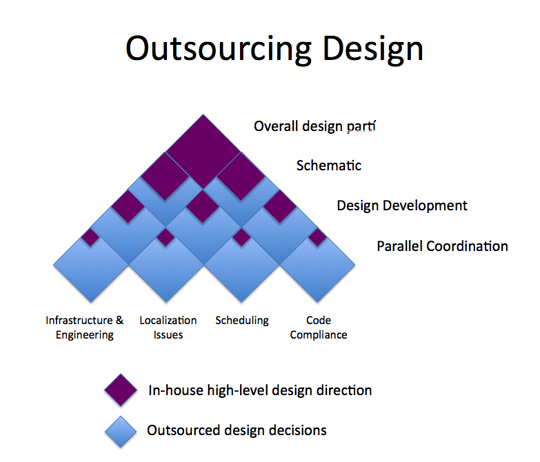
The division of labor for design tasks involves multiple levels of decision-making, with the primary design firm providing overall guidance, with the outsource firms also responsible for some portion of the creative work.
Design is quantifiable in some ways, in terms of quality control and noticing where the process works and where it doesn’t. Outsourced designs already occur in other industries such as product design, clothing design, and manufacturing design (prototypes).
Outsourcing can help smaller firms to win bigger projects without having to ramp up and do it all themselves.
Darren: It’s one way for a smaller firm to have a bigger piece of a project than they would otherwise be able to handle. That’s one thing that small firms who were early adopters of BIM and Revit taught us all. They made the transition from using drawing tools to information modeling. Suddenly a small firm could produce the same quantity of work as teams three times their size. A firm of 2-3 people could manage an outsource team of 10.
By teaming up with an outsourcing firm, not only can small firms do more work, they can gain work in new sectors, with the outsourcing firm providing specified expertise and skill sets that the bidding firm may not possess themselves.
Outsourcing for small firms can be beneficial in that they don’t have as much employee overhead. They can staff by project and gain the ability to scale. The downside is that you have to pay the outsource firm on a regular basis. You might get paid based on milestones of project completion, but the outsource firm may need to be paid monthly. So you have to plan for this upfront.
Any famous last words?
Darren: Hmm, how about “Try it, you might like it”? More seriously, don’t view outsourcing as a necessary evil. Embrace it as a way to grow your business and increase your reach. It’s all in how you use it.

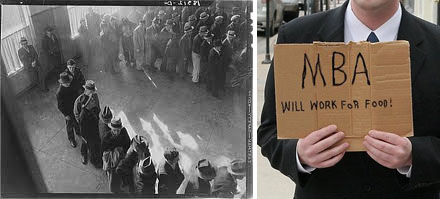








Philip Combs
24. Sep, 2010
Architects and designers might also consider working more closely with G.C.s (I am one) and their subcontract teams to specify projects. I am currently working with an AIA architect who spent money hiring a mechanical engineering engineer to do plans on a Hydronic system which is not only not economically feasible but which wasn’t needed, as my sub can get Building Authority approval at the time of installation.
Outsourcing can be with us; the folks who will build the Project.